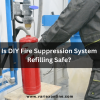![]()
Fire Immuniser
+91-7829629111
Email: info@variex.in
Varistor Technologies Pvt. Ltd.
Block-1, First Floor, Ardente Office One, Hoodi Circle, ITPL Main Road, Bengaluru, Karnataka 560048, IN
What are the Ingredients Used in Fire Extinguishers?
When a fire explodes, homeowners or business experts have little time to think beyond putting it out. So it’s time to think about the type of fires you are most likely to deal with especially when you are going to select fire extinguishers. A Fire extinguisher is an essential device safeguarding the lives of the masses and properties with utmost excellence! This active fire protection device is made in such a way to put out the fire by cooling the burning material.
Fire extinguishers surpass the oxygen flames and interfere with the chemical reactions occurring in the flame, effectively. Fire Extinguishers are manufactured and labeled according to which type of fire they put out as each class of fire is extinguished by different agents. But do you know what makes it so distinctive?
Let’s take a closer look at ingredients (what chemical composition uses) in this device helping control fire.
The Label
The ingredients used in each type of fire extinguisher are capable of detecting the type of fire it puts out. Every category of fire extinguisher has a color-coded label that indicates the class of fire for which it is projected.
- Class A Fire Extinguishers – Used with ordinary combustibles, ex – wood, paper, and cloth, etc.
- Class B Fire Extinguishers – Used for flammable liquids, ex-oil, grease, gasoline and paint thinner, etc.
- Class C Fire Extinguishers – Used for electrical fires
- Class D Fire Extinguishers – Used for flammable metals, ex – magnesium
- Class K Fire Extinguishers – Used for extinguishing cooking combustibles, ex – animal and vegetable fats, cooking oils, etc.
1. Dry Chemicals
- Mono ammonium phosphate – NH₆PO₄ is a dry chemical used in Class A, B, and C fire extinguishers. It is nonconductive, but then again corrosive, so it must be cleaned up soon after extinguishing the fire.
- Sodium bicarbonate – NaHCO3 is another dry chemical used in fire extinguishers for extinguishing B and C fires. It is a nontoxic, noncorrosive dry chemical that requires minimal cleanup.
- Potassium bicarbonate – KHCO3 is a dry chemical used in Class B and C fire extinguishers. It is non-conductive as well as non-corrosive and easily cleaned after the fire is extinguished.
2. Wet Chemicals
These chemicals are an essential constituent of Class K fire extinguishers that contain a potassium acetate-based agent. This agent is used by discharging from the extinguisher as a fine mist that forms a soapy foam, which suppresses any vapors and steam and prevents fire to reignite.
3. Halotron/Halon
It is an ozone-friendly vaporizing liquid used in extinguishers to extinguish types A, B, and C fires that leave no residue behind and causes no damage to the electrical equipment. It requires no cleanup and causes no damage to electrical equipment. However, Halon extinguishers are no longer made, because dangerous gases are formed when halon is used to put out fires, but some may still be in use. For this reason, respiratory equipment must be worn when these extinguishers are used, and the area must be well ventilated afterward.
4. Carbon Dioxide
Carbon Dioxide or CO2 is an essential environmentally-friendly fire extinguisher ingredient that separates oxygen from the fire effectively, causing minimal damage. Carbon dioxide can be used around electrical equipment with minimal damage and leaves a minimal mess.
5. Metal Powders
Metal powders such as copper or sodium chloride – NaCl, and sand are found in Class D extinguishers. Powdered copper extinguishes fires fueled by lithium and lithium alloy metals; sodium chloride extinguishers work best for fires involving uranium, powdered aluminum, magnesium, potassium, and sodium.










Good post. I will be going through some of these issues as well..